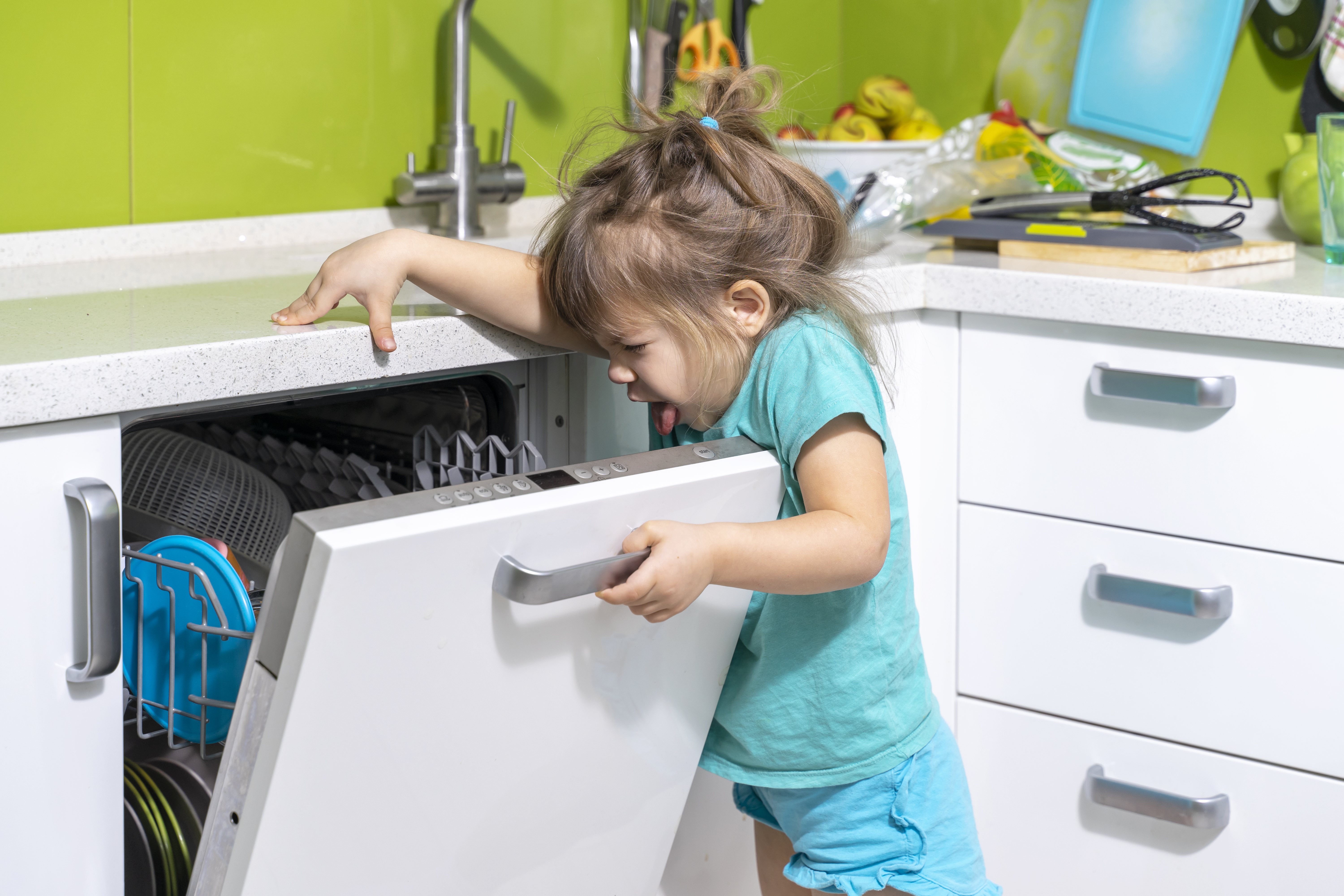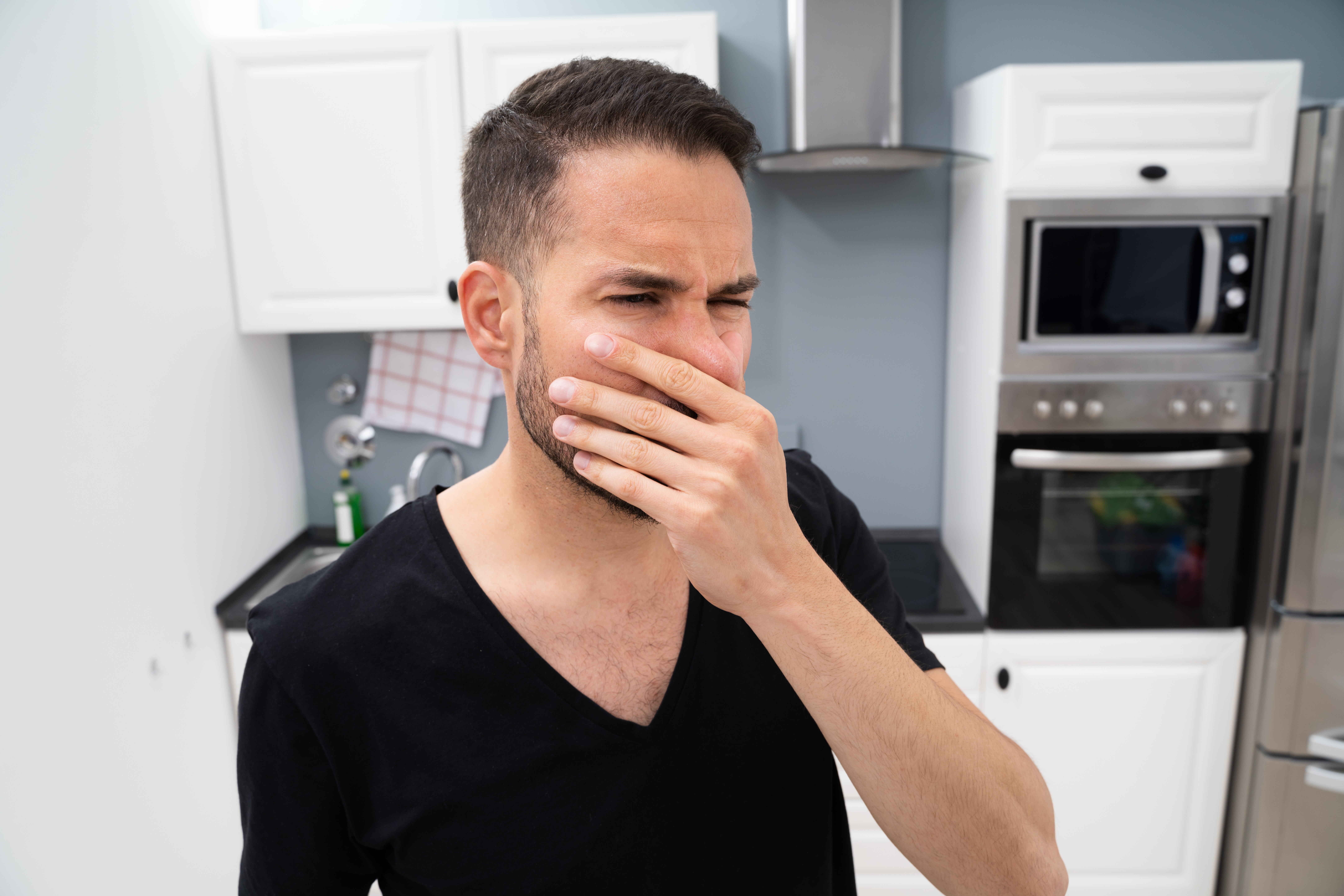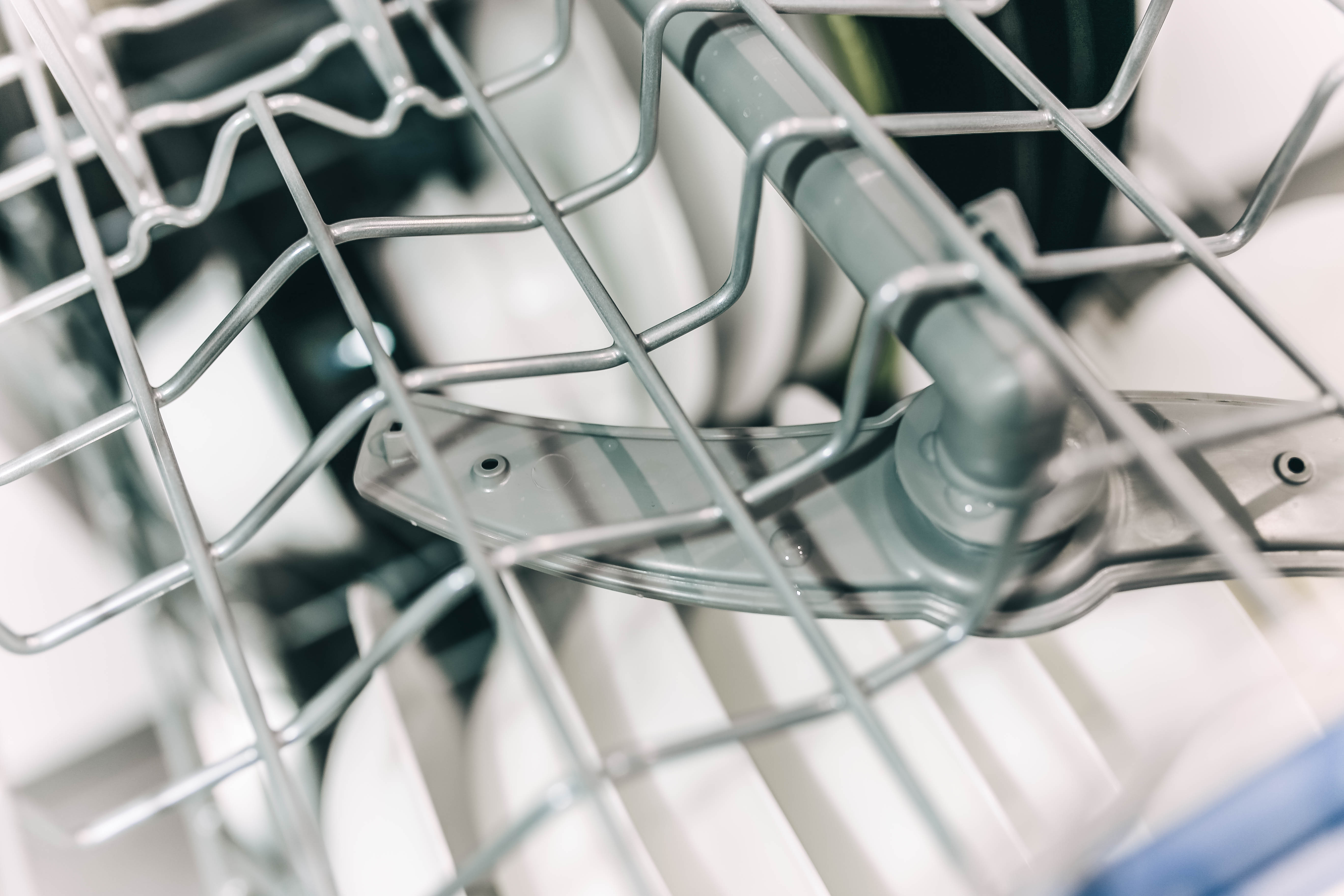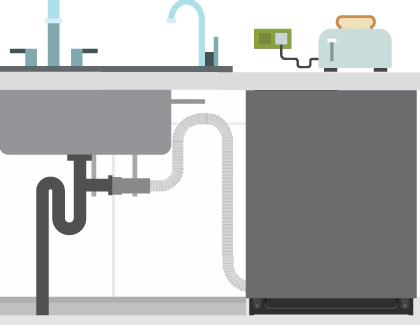
At a Glance:
Reasons Why Your Dishwasher Smells
Solution 1: Cleaning a Dirty Dishwasher Filter
Solution 2: Maintaining Dishwasher Arms
Solution 3: Fixing Your Drain Hose Connection
Solution 4: Adjusting Your Dishwasher’s Water Temp
There’s no shortage of chores throughout the home, so when it comes to cleaning a dishwasher, users often think the job is redundant. There’s plenty of logic to the argument. Dishwashers use high-temperature water and soap to wash dishes, so the inside of the appliance should be clean too — right?
That all checks out until your dishwasher starts to smell funny. The fact is dishwashers do require regular cleaning to prevent them from smelling funky and to keep your dishes safe to use. Luckily, we’re here to teach you how to get smell out of dishwasher appliances in this quick guide. Follow along for tips and tricks from our experts.

Learn More: Guide to Dishwasher Shopping
Why Does My Dishwasher Smell Bad?
When you think about it, dishwashers play a very important role in the home: keeping your dinnerware clean and safe to eat on. When a dishwasher is not properly taken care of, bad smells start to develop, or even worse, traces of bacteria like E. Coli, salmonella, and listeria can start to grow on the inside. That’s because bacteria flourishes in wet, humid environments — especially if there are food particles for a colony of bacteria to thrive on.
Additionally, rubber gaskets and plastic tubs, which are porous, are ideal places for bacteria and odors to form, resulting in a smelly dishwasher. Identifying the source isn’t always easy, but knowing where to look can help crack the case of the stinky dishwasher a little easier. Here are four common reasons your dishwasher might be smelling bad.
Shop Built-In Dishwashers at Albert Lee
Discover the built-in dishwashers that make clean-up easier than ever before.
Built-In DishwashersSmelly Dishwasher Problem: A Clogged Dishwasher Filter

If you’ve purchased a dishwasher within the past decade, you’re in luck. Chances are your dishwasher has a food filter — a mesh basket at the bottom of a dishwasher’s tub that catches food particles. A dishwasher filter basket is essential for keeping wash water clear of debris which can otherwise lead to specks. However, users often don’t realize a dishwasher filter basket needs to be cleaned regularly to avoid “sewage” smells.
A big indication a food filter is the reason your dishwasher stinks is if you only sense bad smells when the dishwasher is open and if odors are not coming from the sink.
The good news is cleaning a dishwasher filter basket is simple. This is how to clean a clogged dishwasher filter:
- Start by removing the bottom dishwasher rack for easier access to the tub.
- Once the bottom rack is out, remove the fine mesh strainer by turning it counterclockwise and lifting it out.
- Depending on your dishwasher model, there may be an additional large mesh cover that also detaches. Remove this cover by lifting it out and checking for any food particles or foreign objects that might be beneath it.
- After inspection, clean the filter(s) with hot water and soap.
- Replace the filters.
If your dishwasher doesn’t have a removable filter, you can still prevent your appliance from developing odors by using dishwasher cleaning tablets. Run an empty cycle on the hottest setting (self-clean, if possible) to give a non-removable dishwasher filter a thorough cleaning.
Smelly Dishwasher Problem: The Dishwasher Arms Need to Be Cleaned

Though less of offenders, spray arms could be a reason for dishwasher odor. In fact, if you don’t clean your dishwasher filter regularly, food particles could be making their way back into the water system and clogging the waterspouts in your dishwasher’s spray arms.
In most cases, a clogged dishwasher spray arm has a bigger impact on cleaning results, but routine cleaning is an easy way to prevent smells while also maintaining a hygienic wash.
Here’s how to clean a clogged dishwasher arm:
- First, remove the bottom dishwasher rack to access the spray arm easier.
- Once the rack is removed, detach the spray arm. Depending on the brand and model, this is done by either spinning counterclockwise or removing a locking tab.
- After removing the spray arm, inspect the spray holes for debris. Remove any particles with a fine-point object like a safety pin, hanger, or a toothpick.
- Next, run water through the spray arm from the connector.
- After rinsing, replace the spray arm and repeat for any other spray arms.
Smelly Dishwasher Problem: It’s Your Sink’s Garbage Disposal Drain
Did you know garbage disposals share a drain line with a dishwasher? When installed correctly, water that drains from a dishwasher flushes through the disposal drain, carrying away debris and odor as it empties. But if you notice smells coming from the sink (as well as the dishwasher), two issues with your sink’s disposal setup could be causing a smelly dishwashing machine:
- The dishwasher hose is installed wrong.
- The garbage disposal air gap needs to be flushed.
About Dishwasher Hoses

Let’s address the more complicated issue first — the dishwasher hose. This kinked connector is the last stop for outgoing water from the dishwasher to your kitchen sink, regardless of whether or not your setup includes a food disposal system.
When installed correctly, a dishwasher hose rises high before looping back down and connecting to a drain line (like an upside-down U connected by a straight line of tubing). A high loop is important because it keeps water from re-entering the dishwasher, where it pools at the bottom of the tub and causes odors.
If your hose isn’t damaged, you can readjust your dishwasher hose by:
- First, unclip the hose from the drain line. Often, the hose will be connected with a spring clip, so pliers will be useful.
- Once disconnected, use a hook, tape, or a high drain loop bracket to place the hose in the right position.
- Finally, reconnect the hose to the drain line.
About Disposal Air Gaps
You might have noticed a small adapter on your kitchen sink covered by a metal cap. This is the disposal air gap, and it is used to create a natural barrier of air between wastewater and your dishwasher and sink. However, food and other objects that are siphoned off during dishwashing occasionally get stuck here and create smells.
To solve a smelly disposal air gap, simply uncover the cap and run water down the reservoir. If you wish, you can pour baking soda and white vinegar down the garbage disposal to disinfect any odors from food being trapped in the air gap.
Smelly Dishwasher Problem: The Water Isn’t Hot Enough
Sometimes, the problem with a stinky dishwasher is that your home’s water isn’t hot enough. Some call it the “wet dog smell,” while others call it a fishy scent. All the same, it’s one of the many reasons users are searching “how to get smell out of dishwasher” in the query.
Besides off smells, tell-tale signs your dishwasher isn’t getting hot enough include spotty dishes and loads that are still dirty at the end of their cycle. Ideally, you want your dishwasher to run between 120 and 150 degrees to kill off the bacteria that causes a fishy smell on your dishes. The easiest way to test your home’s water temperature is by running your sink on its hottest setting, pouring the hot water into a cup, and testing its temperature with a thermometer.
If it’s less than 120 degrees, increasing the temperature on your water heater might be the solution to your smelly dishwasher.
Enjoy Top Dish Care: Best Built-in Dishwasher Reviews
✱
Regardless of whether your dishwasher smells or not, it’s good to know how to keep your machine clean and sanitary. A properly maintained dishwasher runs more efficiently, reduces exposure to harmful bacteria, and keeps your kitchen from smelling like a sewer line. Hopefully, these tips are enough to solve your smelly dishwasher, but if bad odors continue to plague your kitchen, it might be time to upgrade to a new dishwasher.
Smelly Dishwasher FAQs
Here are a few more dishwasher cleaning hacks to solve the mystery of any bad smells.
How do you disinfect a dishwasher?
The easiest way to disinfect your dishwasher is by using vinegar. First, empty the dishwasher, then place a bowl on the bottom rack and fill it with vinegar. You don’t need a specific amount, but a cup should do. Then, run your dishwasher on its hottest setting.
After disinfecting, we recommend running an empty load one more time to rinse any remaining bacteria and limescale residue away.
How often should you deep clean your dishwasher?
How often you should wash your dishwasher depends on how often you use it. Good practice suggests deep-cleaning your dishwasher every two months, while households with high-frequency demands can deep clean every month. At the minimum, a dishwasher should be thoroughly cleaned and disinfected once every six months.
Why Trust Us?
Since 1939, Albert Lee Appliance, a three-generation, family-owned business, continues to grow and serve the greater Seattle area with quality you can count on and service you can trust. We are proud to have served this community for so long and wouldn’t be here without our loyal customers. There is a reason why we are Washington’s largest independent appliance dealer, and it’s not a secret. Simply put: We have the experience. We are the original appliance experts for over eight decades (and counting).
Shop Dishwashers at Albert Lee Appliance
At Albert Lee Appliance, we provide quality name-brand appliances for great prices. Shop dishwashers online or visit us today at one of our locations in Puget Sound, WA. In the meantime, browse our website to shop Albert Lee appliance sales and check out Albert Lee appliance reviews online to ensure every purchase is an informed one. More available than ever, our experts at Albert Lee Appliance are always happy to help you solve the mystery to your smelly dishwasher, whether you call us or use our online chat feature. Contact us today!
Learn More: Sanitize Features in Dishwashers
